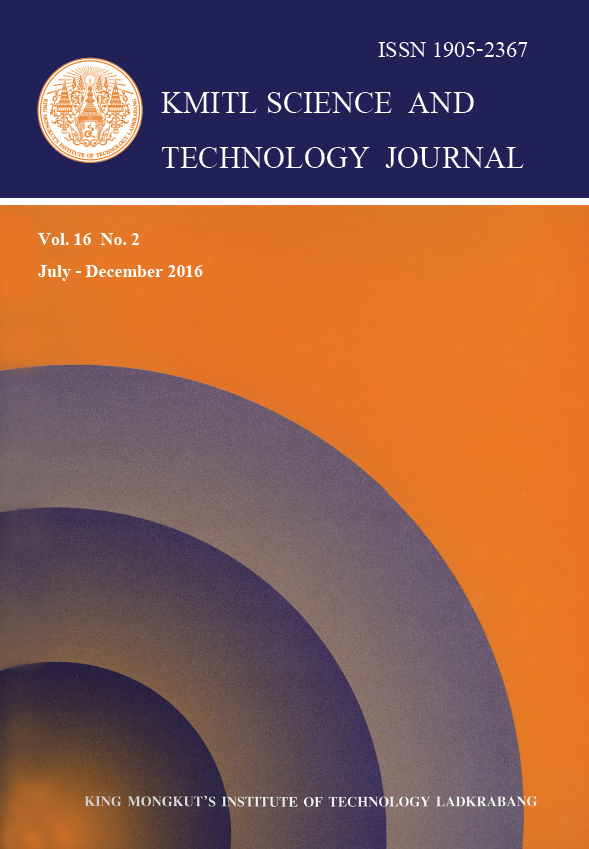Bacteriocins from Lactobacillus strains and their anti-Listeria monocytogenes in Nham, Thai Fermented Pork
Main Article Content
Abstract
In this study, two bacteriocin-producing Lactobacillus strains (the isolates LS0602 and LT0904) isolated from Thai fermented pork products were identified by 16S rDNA sequence analysis. The isolate LS0602 was found to be Lactobacillus plantarum, whereas the isolate LT0904 was Lactobacillus brevis. Their bacteriocins were partially purified by ammonium sulfate precipitation, dialysis and trichloroacetic acid precipitation. Bacteriocin activity was determined by agar well diffusion assay and critical dilution method against Listeria monocytogenes. The partial purified bacteriocins from L. plantarum LS0602 and L. brevis LT0904 had strong inhibitory activity against the growth of L. monocytogenes at 819,200 AU/ml and 409,600 AU/ml, respectively. These bacteriocins were used to control the growth of L. monocytogenes in Nham during fermentation at 30°C. The partial purified bacteriocins (4%) in combination with L. plantarum LS0602 starter culture could reduce the number of total presumptive Listeria counts in Nham by 1.5 log unit after 3-day fermentation.
Keywords: Lactic acid bacteria, bacteriocins, fermented meat, starter culture
*Corresponding author: snanasombat@gmail.com
Article Details
Copyright Transfer Statement
The copyright of this article is transferred to Current Applied Science and Technology journal with effect if and when the article is accepted for publication. The copyright transfer covers the exclusive right to reproduce and distribute the article, including reprints, translations, photographic reproductions, electronic form (offline, online) or any other reproductions of similar nature.
The author warrants that this contribution is original and that he/she has full power to make this grant. The author signs for and accepts responsibility for releasing this material on behalf of any and all co-authors.
Here is the link for download: Copyright transfer form.pdf
References
[2] Jemmi, T., Pak, S.I. and Salman., M.D., 2002. Prevalence and risk factors for contamination with Listeria monocytogenes of imported and exported meat and fish products in Switzerland, 1992–2000. Preventive Veterinary Medicine, 54, 2536.
[3] Owens, J.D., 2015. Indigenous fermented foods of southeast asia. Boca Raton, FL, USA: Taylor & Francis Group.
[4] Työppönen (née Erkkilä), S., Markkula, A., Petäjä, E., Suihko, M.-L and Mattila-Sandholm, T., 2003. Survival of Listeria monocytogenes in North European type dry sausages fermented by bioprotective meat starter cultures. Food Control, 14, 181185.
[5] Nanasombat, S. and Charoenrak, N., 2012. Characterization of lactic acid bacteria and coagulase negative staphylococci isolated from raw meat and cured meat products. Asian Journal of Food and Agro-Industry, 5, 531539.
[6] Nanasombat, S. and Charoenrak, N., 2012. Bacteriocin production by lactic acid bacteria isolated from meat products and their applications as biopreservative. In: the Proceeding of the 38th congress on Science and Technology of Thailand (pp. 16), October 1719, 2012, Empress Convention Centre, Chiang Mai, Thailand.
[7] Nanasombat, S., Phunpruch, S., Sriwong, N., Jaichalad, T., Onnom, W. and Odthon, S., 2008. Characterization of the antibacterial activity and probiotic properties of lactic acid bacteria isolated from raw fish and Nham-Plaa. Kasetsart Journal (Natural Science), 42, 747757.
[8] Altschul, S.F., Gish, W., Miller, W., Myers, E.W. and Lipman, D.J., 1990. Basic local alignment search tool. Journal of Molecular Biology, 215, 403–410.
[9] Ogunbanwo, S.T., Sanni, A.I. and Onilude, A.A., 2003. Characterization of bacteriocin produced by Lactobacillus plantarum F1 and Lactobacillus brevis OG1. African Journal of Biotechnology, 2, 219227.
[10] Bradford, M.M., 1976. A rapid and sensitive method for the quantitation of microgram quantities of protein utilizing the principle of protein-dye binding. Analytical Biochemistry, 72, 248254.
[11] Schillinger, U. and Lücke, F.K., 1989. Antibacterial activity of Lactobacillus sake isolated from meat. Applied and Environmental Microbiology, 55, 19011906.
[12] Yousef, A.E. and Carlstrom, C. 2003. Food microbiology: A laboratory manual. Hoboken, NY, USA: John Wiley & Sons Inc.
[13] Garriga, M., Aymerich, M.T., Costa, S., Monfort, J.M. and Hugas, M., 2002. Bactericidal synergism through bacteriocins and high pressure in a meat model system during storage. Food Microbiology, 19, 509518.
[14] Rajalingam, D., Loftis, C., Xu, J.J. and Kumar, T.K., 2009. Trichloroacetic acid-induced protein precipitation involves the reversible association of a stable partially structured intermediate. Protein Science, 18, 980993.
[15] Kingcha, Y., Tosukhowong, A., Zendo, T., Roytrakul, S., Luxananil, P., Charoenpornsook, K., Valyasevi, R., Sonomoto, K. and Visessanguan, W., 2012. Anti-listeria activity of Pediococcus pentosaceus BCC 3772 and application as starter culture for Nham, a traditional fermented pork sausage. Food Control, 25, 190196.


